Complementary Therapies to Help Manage Pain in Horses
By: Shannon J. Murray, DVM, MS, DACVS-LA | Updated September 15, 2025

From pinned ears to refusing to eat and repeatedly rolling, horses can give us a variety of physical and behavioral clues to communicate that they may be in pain. While recognizing the signs of pain in horses is crucial, getting them prompt and appropriate care to alleviate their discomfort and prevent further pain is key.
There are a variety of therapies, medications, and supplements that may be used alone or in various combinations to help manage pain in horses. Below, we dive into complementary therapies you can provide to your horse to help manage their pain, while we cover medications to address inflammation and discomfort in separate articles.
As always, we encourage you to work with your veterinarian to find the right treatment and pain management plan to keep your individual horse as comfortable as possible.
Complementary Therapies for Equine Pain Management
While medications are often the first option owners turn to for lessening their horse’s pain, it is important to recognize that alternative therapies may effectively and noninvasively ease discomfort with potentially fewer side effects. Studies have looked at non-pharmacological complementary therapies and found them to aid in pain management, tissue healing, and behavioral aspects [1].
The Whole Horse Perspective
Integrative therapy is a combination of complementary medicine and conventional western practice which aims to look at the whole-horse perspective for optimal health and wellness.
There are many complementary therapies which may be used to target specific aspects of your horse’s health. Another benefit of complementary therapies is that many options can be used for long term pain management. Some treatments must be performed by a licensed veterinarian while others require skilled practitioners. Speak with your equine veterinarian about whether any of the options mentioned below may be helpful for your unique horse.
Acupuncture Treatments for Equine Pain Relief

Acupuncture may be used to address pain through the release of the neurotransmitters serotonin, dopamine, and norepinephrine (endogenous opioid peptides [2]). By stimulating specific points (acupuncture points) on the body with precise methods, a homeostatic or therapeutic effect may occur. Variations of techniques, from traditional needles to electroacupuncture, have more frequently been used in pain management protocols, and you can learn all about acupuncture for horses in this article.
Manual Therapies for Pain Management in Horses
Hands-on, manual therapy (also called manipulative therapy) aims to reduce pain in connection to sensory, neuromuscular, and mechanical abnormalities. These techniques may be used by skilled practitioners to manipulate muscles, nerves, and joints. Some manual therapies for horses include:
- Chiropractic (Veterinary Spinal Manipulation): Aims to restore normal nerve and muscle function as well as range of motion. Chiropractic care has been shown to reduce equine spinal pain with long term benefits.
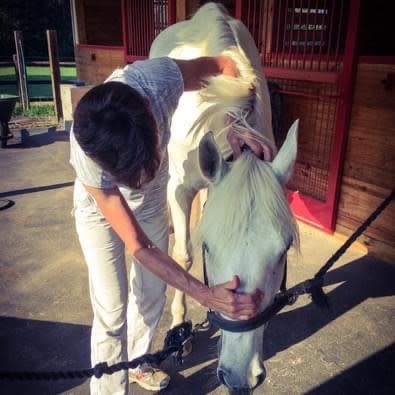
- Massage: One of the oldest known ways to naturally improve pain by relieving muscle tightness and lymphatic circulation. A few benefits of equine massage include improved blood flow, changes in neurologic signaling for pain processing, and the release of peptides that may modulate pain perception.
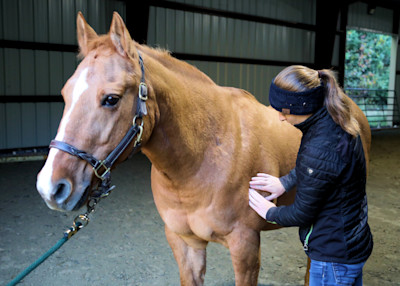
Image courtesy of The Missing Piece Equine Sports Therapy. - Cold Therapy: Can be performed at the barn through cold water hosing and applying ice packs. Often, cold therapy for horses is most helpful for easing pain when applied as soon after the injury occurred as possible. The cold temperature paired with compression (ice leg wraps, bandages, etc.) provide analgesia (pain relief) through a variety of measures, including decreasing inflammation.
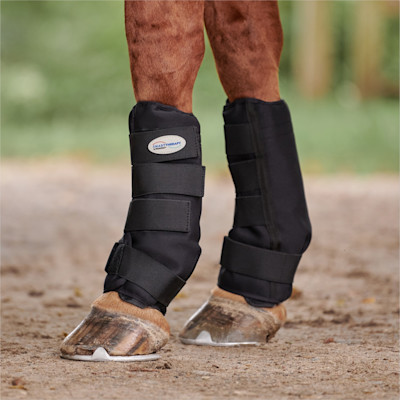
- Extracorporeal Shock Wave Therapy: Shock wave treatments have been shown to reduce pain and improve healing in humans, as well as provide analgesia in horses.
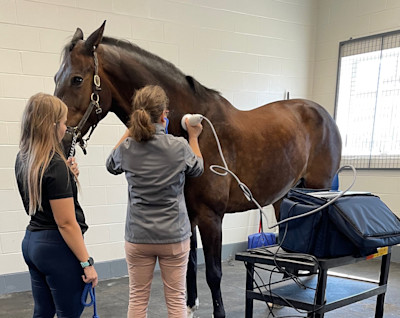
- Kinesiology Taping: Performed with the thought that the constant pressure on the skin may decrease pain perception through the downregulation of nociceptors. However, scientific research is needed to provide more evidence on the role of taping practices for pain relief in horses.
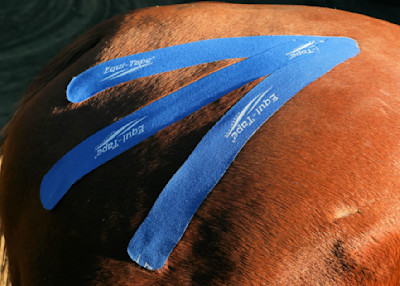
- Therapeutic Ultrasound and Laser Therapy: Both veterinary treatments have been shown to provide analgesic effects in humans and have been increasing in popularity in equine medicine.
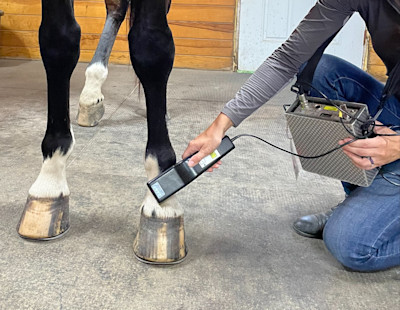
Other Strategies for Managing Discomfort in Horses
Proper Weight Management
Decreasing your horse’s body fat may lessen the physical load on their joints and internal tissues. Assess your horse’s body condition using the Henneke Body Condition Scoring System, using a weight tape for measurements, or by asking your veterinarian if they think your horse may be overweight. Inflammation in aging horses (referred to as inflammaging) may be accentuated by excess body fat.
Key Takeaways
Complementary therapies offer owners a powerful set of non-pharmaceutical tools to help reduce pain, promote healing, and improve their horse’s quality of life—especially when used alongside traditional veterinary care. Whether you’re interested in acupuncture, chiropractic adjustments, or cold therapy, these alternative methods can provide effective, natural pain relief. Always consult your veterinarian or a qualified practitioner to develop a tailored pain management plan for your horse’s specific needs.
For more tips on supporting your horse’s comfort and health, explore our related equine therapy articles and recommended wellness solutions.
Evidence-Based References
- Adair, Steve. “Integrative Philosophy: Case Management.” The Veterinary clinics of North America. Equine practice vol. 38,3 (2022): 455-461. doi:10.1016/j.cveq.2022.06.004
- Daglish, Jodie, and Khursheed R Mama. “Pain: Its Diagnosis and Management in the Rehabilitation of Horses.” The Veterinary clinics of North America. Equine practice vol. 32,1 (2016): 13-29. doi:10.1016/j.cveq.2015.12.005
- van Loon, J P A M, and M C Van Dierendonck. “Objective pain assessment in horses (2014-2018).” Veterinary journal (London, England : 1997) vol. 242 (2018): 1-7. doi:10.1016/j.tvjl.2018.10.001
- Muir, William W. “Pain: mechanisms and management in horses.” The Veterinary clinics of North America. Equine practice vol. 26,3 (2010): 467-80. doi:10.1016/j.cveq.2010.07.008
- Love, EJ. “Equine Pain Management”. Equine Surgery. Auer and Stick. 263-268.
- Guedes, Alonso. “Pain Management in Horses.” The Veterinary clinics of North America. Equine practice vol. 33,1 (2017): 181-211. doi:10.1016/j.cveq.2016.11.006
- de Grauw, J C, and J P A M van Loon. “Systematic pain assessment in horses.” Veterinary journal (London, England : 1997) vol. 209 (2016): 14-22. doi:10.1016/j.tvjl.2015.07.030
- Mama, Khursheed R, and Rachel C Hector. “Therapeutic developments in equine pain management.” Veterinary journal (London, England : 1997) vol. 247 (2019): 50-56. doi:10.1016/j.tvjl.2019.02.010





